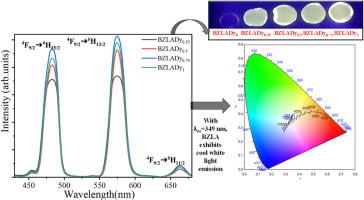当前位置:
X-MOL 学术
›
Opt. Mater.
›
论文详情
Our official English website, www.x-mol.net, welcomes your feedback! (Note: you will need to create a separate account there.)
Enhanced white light emission and quantum efficacy of borate-zinc–lithium-aluminium glasses doped with Dy2O3 for potential white light emission applications
Optical Materials ( IF 3.9 ) Pub Date : 2024-04-15 , DOI: 10.1016/j.optmat.2024.115359 Namrata Yaduvanshi , Ch Basavapoornima , Areej S. Alqarni , Upendra Kumar Kagola , T. Uthayakumar , A. Madhu , N. Srinatha
Optical Materials ( IF 3.9 ) Pub Date : 2024-04-15 , DOI: 10.1016/j.optmat.2024.115359 Namrata Yaduvanshi , Ch Basavapoornima , Areej S. Alqarni , Upendra Kumar Kagola , T. Uthayakumar , A. Madhu , N. Srinatha

|
The pursuit of efficient and enhanced white light emission in glasses doped with rare earth ions is a noble endeavour, one that has the potential to revolutionise many industries and benefit countless individuals. In view of this, we have prepared the Dy ions doped Borate-Zinc–Lithium-Aluminium glasses via melt-quenching methods and their properties were meticulously studied using XRD, Raman, FTIR, DSC, Luminescence and time decay kinetic studies. To evaluate the influence of DyO doping, various physical parameters were analysed. The integration of DyO into the host glass matrix causes significant changes in the numerous physical parameters due to the geometrical structural change, resulting in the formation of non-bridging oxygens (NBOs), resulting in the increased compactness, thus the density and refractive index of the glasses. The DSC profile analysis reveals the thermal stability of the glasses. The UV–visible–NIR absorption spectra reveal the presence of a pronounced peak, owing to a hyperfine transition and other transitions dependent on the host. Furthermore, the Judd-Ofelt theory was applied to support the experimental results and evaluate the radiative parameters and efficiency. It was discovered that the JO parameters are in the following order: Ω> Ω> Ω. The luminescence emission enhancement was observed with DyO, up to 0.75 mol%; beyond that, the concentration quenching effect was observed. The glasses were proficiently fitted to the Inokuti-Hirayama model. Colorimetric parameters such as CIE coordinates, correlated colour temperature, and yellow-to-blue intensity ratios were estimated. It was discovered that, the sample containing 0.75 mol% of DyO doped glass is capable of white light emission with 72 % efficiency under excitation of 349 nm. Overall, present studies demonstrate that the thermal stability of glasses with phonon energy of 1330 cm, when stimulated at 349 nm and capable of producing white light, offers considerable benefits in relevant applications in the field of wLEDs.
中文翻译:

掺杂 Dy2O3 的硼酸锌锂铝玻璃的增强白光发射和量子效率,用于潜在的白光发射应用
在掺杂稀土离子的玻璃中追求高效和增强的白光发射是一项崇高的努力,它有可能彻底改变许多行业并造福无数个人。鉴于此,我们通过熔融淬火方法制备了镝离子掺杂的硼酸锌锂铝玻璃,并利用 XRD、拉曼、FTIR、DSC、发光和时间衰减动力学研究对其性能进行了仔细研究。为了评估 DyO 掺杂的影响,分析了各种物理参数。 DyO 融入基质玻璃基体后,由于几何结构的变化,导致众多物理参数发生显着变化,从而形成非桥接氧(NBO),从而导致致密性增加,从而提高了玻璃的密度和折射率。眼镜。 DSC 曲线分析揭示了玻璃的热稳定性。紫外-可见-近红外吸收光谱显示,由于超精细跃迁和依赖于主体的其他跃迁,存在明显的峰。此外,应用Judd-Ofelt理论来支持实验结果并评估辐射参数和效率。结果发现,JO参数的顺序为:Ω>Ω>Ω。使用 DyO 观察到发光发射增强,高达 0.75 mol%;除此之外,观察到浓度猝灭效应。该眼镜能够熟练地安装到 Inokuti-Hirayama 模型上。估计了 CIE 坐标、相关色温和黄蓝强度比等色度参数。结果发现,含有0.75 mol% DyO掺杂玻璃的样品在349 nm激发下能够发出白光,效率为72%。总体而言,目前的研究表明,声子能量为 1330 cm 的玻璃的热稳定性在 349 nm 激发时能够产生白光,为 wLED 领域的相关应用提供了相当大的优势。
更新日期:2024-04-15
中文翻译:

掺杂 Dy2O3 的硼酸锌锂铝玻璃的增强白光发射和量子效率,用于潜在的白光发射应用
在掺杂稀土离子的玻璃中追求高效和增强的白光发射是一项崇高的努力,它有可能彻底改变许多行业并造福无数个人。鉴于此,我们通过熔融淬火方法制备了镝离子掺杂的硼酸锌锂铝玻璃,并利用 XRD、拉曼、FTIR、DSC、发光和时间衰减动力学研究对其性能进行了仔细研究。为了评估 DyO 掺杂的影响,分析了各种物理参数。 DyO 融入基质玻璃基体后,由于几何结构的变化,导致众多物理参数发生显着变化,从而形成非桥接氧(NBO),从而导致致密性增加,从而提高了玻璃的密度和折射率。眼镜。 DSC 曲线分析揭示了玻璃的热稳定性。紫外-可见-近红外吸收光谱显示,由于超精细跃迁和依赖于主体的其他跃迁,存在明显的峰。此外,应用Judd-Ofelt理论来支持实验结果并评估辐射参数和效率。结果发现,JO参数的顺序为:Ω>Ω>Ω。使用 DyO 观察到发光发射增强,高达 0.75 mol%;除此之外,观察到浓度猝灭效应。该眼镜能够熟练地安装到 Inokuti-Hirayama 模型上。估计了 CIE 坐标、相关色温和黄蓝强度比等色度参数。结果发现,含有0.75 mol% DyO掺杂玻璃的样品在349 nm激发下能够发出白光,效率为72%。总体而言,目前的研究表明,声子能量为 1330 cm 的玻璃的热稳定性在 349 nm 激发时能够产生白光,为 wLED 领域的相关应用提供了相当大的优势。



























 京公网安备 11010802027423号
京公网安备 11010802027423号